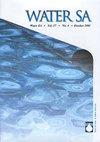The potential of decentralised wastewater treatment in urban and rural sanitation in South Africa: lessons learnt from a demonstration-scale DEWATS within the eThekwini Municipality
IF 1.2
4区 环境科学与生态学
Q4 WATER RESOURCES
引用次数: 1
Abstract
The design principles of decentralised wastewater treatment systems (DEWATS) make them a practical sanitation option for municipalities to adopt in fast-growing cities in South Africa. Since 2014, a demonstration-scale DEWATS with a modular design consisting of a settler, anaerobic baffled reactor (ABR), anaerobic filter (AF), vertical down-flow constructed wetland (VFCW) and horizontal flow constructed wetland (HFCW) has been in operation in eThekwini. A performance evaluation after the long-term operation was undertaken in 2019 by comparing the final effluent with national regulatory requirements. Despite limitations in characterising the raw wastewater, a comparison of the settler and final effluent quality indicated high (≥ 85%) removal efficiencies of total chemical oxygen demand (CODt), ammonium-N (NH4-N) and orthophosphate-P (PO4-P), 75% removal of total suspended solids (TSS) and 83.3% log10 removal of Escherichia coli. Lack of exogenous and endogenous carbon and high dissolved oxygen (DO) concentrations (> 0.5 mg‧L−1) inhibited denitrification in the HFCW, resulting in 12.5% of the effluent samples achieving compliance for nitrate-N (NO3-N). Moreover, mixed aggregate media and low residence times in the HFCW may have also contributed to poor NO3-N removal. During the COVID-19 lockdown, an unexpected shutdown and subsequent resumption of flow to the DEWATS indicated a 16-week recovery time based on achieving full nitrification in the HFCW. Although design modifications are necessary for the HFCW, the installation of urine diversion flushing toilets at the household will reduce the nutrient loading to the DEWATS and potentially achieve fully compliant effluent. Alternatively, the application of two-stage vertical flow constructed wetlands to improve denitrification should also be explored in the South African context. With an improved design, DEWATS has the potential to fill the gap in both urban and rural sanitation in South Africa, where waterborne sanitation is still desired but connections to conventional wastewater treatment works (WWTWs) are not possible.分散式污水处理在南非城市和农村卫生设施中的潜力:从德班尼市示范性污水处理系统中吸取的经验教训
分散式污水处理系统(DEWATS)的设计原则使其成为南非市政当局在快速发展的城市中采用的实用卫生选择。自2014年以来,由沉降器、厌氧折流板反应器(ABR)、厌氧过滤器(AF)、垂直下流人工湿地(VFCW)和水平流人工湿地(HFCW)组成的模块化设计的DEWATS示范规模已在埃德克尼省投入运行。2019年,通过将最终出水与国家监管要求进行比较,对长期运行后的性能进行了评估。尽管在原水表征方面存在局限性,但对沉淀池和最终出水水质的比较表明,总化学需氧量(CODt)、氨氮(NH4-N)和正磷酸盐(PO4-P)的去除率很高(≥85%),总悬浮固体(TSS)去除率为75%,大肠杆菌去除率为83.3% log10。缺乏外源和内源碳以及高溶解氧(DO)浓度(> 0.5 mg·L−1)抑制了HFCW中的反硝化作用,导致12.5%的出水样品达到硝酸盐- n (NO3-N)的要求。此外,混合的骨料和较短的停留时间也可能导致NO3-N的去除效果较差。在COVID-19封锁期间,意外关闭和随后恢复到DEWATS的流量表明,在HFCW中实现完全硝化的基础上,需要16周的恢复时间。虽然污水处理厂的设计需要修改,但在家庭中安装尿液分流冲洗厕所将减少污水处理系统的营养负荷,并有可能达到完全合规的排放。另外,还应在南非的背景下探索应用两级垂直流人工湿地来改善反硝化。通过改进设计,DEWATS有可能填补南非城市和农村卫生设施的空白,在南非,人们仍然需要水基卫生设施,但无法与传统的污水处理厂(WWTWs)连接。
本文章由计算机程序翻译,如有差异,请以英文原文为准。
求助全文
约1分钟内获得全文
求助全文
来源期刊

Water SA
环境科学-水资源
CiteScore
2.80
自引率
6.70%
发文量
46
审稿时长
18-36 weeks
期刊介绍:
WaterSA publishes refereed, original work in all branches of water science, technology and engineering. This includes water resources development; the hydrological cycle; surface hydrology; geohydrology and hydrometeorology; limnology; salinisation; treatment and management of municipal and industrial water and wastewater; treatment and disposal of sewage sludge; environmental pollution control; water quality and treatment; aquaculture in terms of its impact on the water resource; agricultural water science; etc.
Water SA is the WRC’s accredited scientific journal which contains original research articles and review articles on all aspects of water science, technology, engineering and policy. Water SA has been in publication since 1975 and includes articles from both local and international authors. The journal is issued quarterly (4 editions per year).
 求助内容:
求助内容: 应助结果提醒方式:
应助结果提醒方式:


